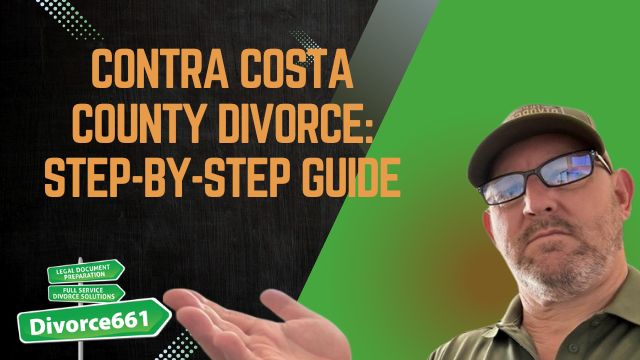Contra Costa County Divorce: Step-by-Step Guide
Hi — I’m Tim Blankenship of Divorce661. If you’re filing for divorce in Contra Costa County, the process can be straightforward when you know the right steps. Below is a practical, step-by-step guide to help you get through filing, serving, disclosures, and finalizing your case — often without ever stepping foot in court.
Quick overview: What to expect
- Prepare the correct forms (Petition, Summons, UCCJEA if children are involved).
- File with the Contra Costa County Court — e-filing is recommended.
- Serve your spouse (a signed Notice of Acknowledgement can simplify service).
- Exchange mandatory financial disclosures.
- If you agree on terms, submit a Marital Settlement Agreement and final judgment — sometimes without a court hearing.
Step 1: Prepare the right forms
The first step is assembling the required paperwork. At a minimum you’ll need:
- Petition for Dissolution — starts the case and states what you’re asking the court to do.
- Summons — notifies the other party they’re being sued and explains response requirements.
- UCCJEA (UCCJEA Declaration) — required if you have minor children; it documents other jurisdictions with child custody connections.
Getting these documents right from the start avoids delays later. If you have complex property, debts, or custody issues, include any supporting declarations or exhibits you’ll need to prove your positions.
Step 2: File with Contra Costa Court (e-filing recommended)
Once your forms are ready, file them with the Contra Costa County Superior Court. E-filing is recommended for speed and accuracy — it’s efficient and keeps a clear electronic trail.
After filing you’ll receive a case number and court-stamped copies of your documents. That stamp marks the official start of your divorce case.
Step 3: Serve your spouse
After filing, you must serve your spouse with the filed paperwork. There are multiple service methods, but the goal is the same: make sure the other party receives legal notice.
A simple way to streamline service is to have your spouse sign a Notice of Acknowledgement. When they sign, it confirms they received the papers and eliminates the need for formal personal service in many cases.
Step 4: Exchange financial disclosures
In California divorces, financial disclosures are mandatory even in amicable cases. Both parties must complete and exchange documents that show income, assets, debts, and expenses. This includes:
- Income and expense declarations
- Preliminary and final disclosures (schedules of assets and debts)
- Supporting documents, like pay stubs, tax returns, and account statements
Missing or incomplete disclosures are one of the most common reasons cases get delayed. Be thorough and timely — it keeps your divorce moving forward.
Step 5: Reach agreement and submit your settlement
If both parties agree on property division, support, and parenting plans, you can prepare a Marital Settlement Agreement (sometimes called a marital settlement or dissolution agreement). When signed and properly submitted with a proposed Judgment, many Contra Costa divorces can be finalized without a court hearing.
“Having all documents correctly filed and approved is crucial for a hassle-free experience.”
I’ve worked with couples who had everything agreed upon but weren’t sure how to finish. We handled the forms, e-filing, and judgment submission — and their divorce was approved without either party going to court.
Common pitfalls and how to avoid them
- Incomplete paperwork: Missing forms or signatures will stall your case. Double-check every document before filing.
- Failed disclosures: Not exchanging accurate financial information can lead to delays, motions, or even sanctions.
- Improper service: If service isn’t done correctly, the court won’t proceed. Use acknowledgement forms when possible to simplify this step.
- Rushing without agreement: Trying to finalize without clear, signed agreements creates risk. Make sure terms are documented and accepted by both sides.
How Divorce661 helps
Divorce661 offers full-service, remote support tailored to Contra Costa County filings. We handle:
- Form preparation and review
- e-Filing and court submission
- Service coordination and proof of service
- Financial disclosure preparation and exchange
- Drafting and submitting judgments and settlement agreements
We operate on flat-fee pricing so there are no surprise costs, and we’ll guide you through the process to avoid common pitfalls. To get started, schedule a free consultation at Divorce661.com.
Conclusion
Filing for divorce in Contra Costa County doesn’t have to be confusing or contentious. Start with the right forms, file correctly (e-filing is your friend), serve properly, and exchange complete financial disclosures. If you and your spouse can agree on terms, a well-drafted Marital Settlement Agreement can carry your case to a final judgment without a hearing.
If you’d like professional help to manage every step remotely and make sure it’s done right the first time, visit Divorce661.com to schedule your free consultation.


